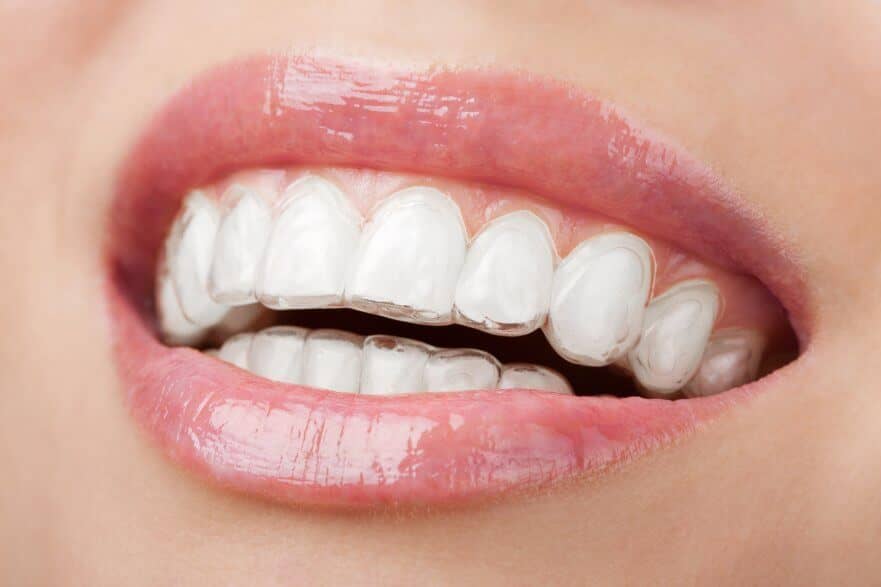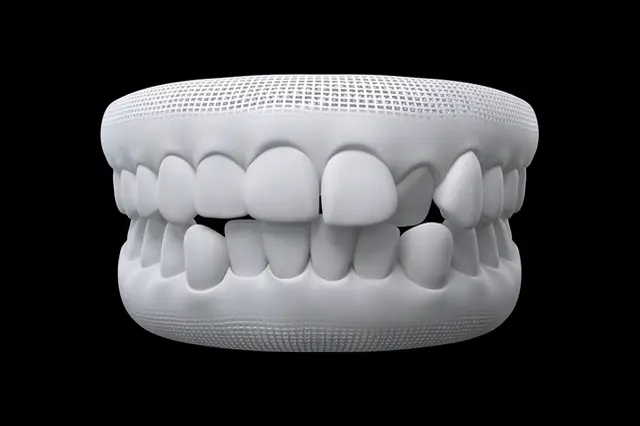Clear Aligners
Invisalign is one type of clear aligner system composed of BPA and BPS-free thermoplastic material. Clear aligners (whether they’re made by Invisalign or another company) work by placing selective pressure on the teeth, changing their position to create your ideal smile. One of the best parts of Invisalign and other types of clear aligners is that the trays are removable, meaning eating and teeth cleaning are a breeze.
A certified specialist in orthodontics has the fundamental core knowledge and training to achieve an Invisalign outcome that not only looks good, but also creates a healthy bite. There’s a reason why orthodontists in Canada spend an additional three years learning how to move teeth. If you’ve ever wondered whether you would be a good candidate for Invisalign, call us to arrange a complimentary consultation with Dr. Ayers.
12 Things to Know
..About Clear Aligner & Invisalign Treatment
Have you been wanting to fix your smile but are hesitant about getting traditional metal brackets on your teeth? Clear Aligners, such as Invisalign, could be a great alternative for you. But before you make a decision here are some helpful tips:
1. Keep your aligners in as much as possible
The first tip is simple; you need to keep your Invisalign aligners in for as long as possible every day. This is the only way you’ll see results. We recommend that you keep your aligners in almost all day. Refrain from taking them out at all unless you have to brush your teeth, eat, or drink.
Your aim should be to keep them in as much as possible. About 22 hours a day is recommended. The longer you have them in, the better it will be for your teeth and the quicker you will get used to them. You will start noticing them less and less, which means no cause for discomfort.
2. You’ll need to adjust how you speak
Invisalign can initially affect your speech. When you first put them in, you may notice a bit of a lisp. It’s important to prepare yourself for this so it won’t shock you as much when you talk. There’s nothing you can do to prevent this, it’s just a natural reaction to having these things in your mouth.
However, it’s worth noting that you won’t have a lisp the whole time you wear them. It will only really be in the first few days as you get used to the change. Make an effort to learn how to speak with your aligners in your mouth. Don’t be tempted to remove them to speak to people. If you keep taking them out, you’ll always have speech problems when they’re in. So, it makes more sense to just prepare for the lisp, and get over it as you wear them. Also, try not to overcompensate too much. Your mouth naturally knows what it needs to do to correct the issue. Practice makes perfect!
3. Invisalign treatment length varies for each person
Every patient and every treatment is different. The length of time depends on the state of your teeth and how much work needs to be done to not only align your teeth but also to fit your bite properly. In simple cases, treatment can be as short as a few months, but you should always trust the evaluation of your oral health to a certified specialist.
Everything will be discussed with you at your initial consultation. Dr. Ayers will do a thorough exam of your teeth and talk you through what to expect, so you know how roughly long your individualized treatment is expected to last for.
4. Quick results
One of the great things about Invisalign is that it doesn’t take long to see results. In fact, most people see them after a couple of months. But this only happens if you revert back to point #1 and keep your aligners in for as long as possible every day!
The treatment comes with a pre-arranged set of clear trays that you wear. You change the trays every 1-2 weeks, depending on each individual case, into a new set of aligners that help bring your new smile into position.
5. Set aside some extra time for daily dental care
With Invisalign, you need to set aside a little extra minute or two as daily dental care takes longer.
For one, you have to brush and floss more often than you would without them. Every time you eat you need to give your teeth a brush and floss. This is because the Invisalign trays will cover your teeth and keep them covered in whatever you just ate. So, you could have sugar stuck to your teeth for hours on end if you don’t brush before putting the aligners back in. This would create the perfect environment for bacteria to thrive and produce acids that eat away at your enamel. You can’t afford to miss any steps during your dental care routine. It may take an extra few minutes and some extra planning, but keeping your teeth clean is essential.
6. Remember to clean your aligners
This is such a big tip for anyone considering Invisalign. As well as looking after your teeth, you also need to look after your aligners. They need to be cleaned every day, just like your teeth. Cleaning them is easy, you just give them a brush with your toothbrush and toothpaste.
We suggest you do this every morning and evening while giving them a quick rinse whenever you take them off during the day. You will also get full cleaning instructions when you first get your Invisalign.
7. You can’t eat or drink with them on
With traditional metal braces there are some food restrictions, a list of foods you can and can’t eat. But with clear aligners, you can easily take them out and eat anything you want! You just can’t eat while you are wearing your aligners in.
There’s also the H20 diet that you should know about. Don’t worry, this isn’t some trending diet that will completely change your lifestyle! Your mouth can get dry quickly when you’re wearing Aligners, but it’s nothing a little bit of water can’t fix. If you regularly drink water, you will find it a lot easier and more comfortable to straighten your smile with the aligners.
Note that only water is recommended to drink when the aligners are on as other liquids can discolour the aligners and get trapped between the aligners and your teeth causing potential cavities!
8. Attachments or buttons may be placed for best results
Sometimes, you may be given attachments that help the aligners to facilitate movement. For extra oomph, you may also require a button to be placed on specific teeth.
They don’t stand out, and are not very noticeable.
9. There’s no age limit
Some people think that there’s an age limit with Invisalign treatment. However, there’s no evidence to suggest this is true. People of all ages can enjoy the benefits of Invisalign.
It will be determined at your initial consultation if Invisalign is the best option for you no matter what your age may be. But keep in mind, they only work for those who are responsible enough to wear them as much as required!
10. You will need a retainer
As with braces, the work doesn’t stop when the treatment is over. When used properly, Invisalign will do a great job of moving your teeth, but it’s up to you to make sure your teeth stay in their new position. Dr. Ayers will discuss the best options for retainers with you towards the end of your treatment at our office.
Too many people forget to wear their retainers, particularly after having braces. As a result, their teeth slowly start shifting again. The good news is, when you have Invisalign trays in your mouth, you tend to get used to wearing an appliance before you go to sleep. So, wearing a retainer really won’t feel strange to you and can be rewarding to know your smile is always going to stay amazing.
11. Adjustments may be made to your teeth
It is worth noting that some minor adjustments may be made to your teeth before or during your treatment. Again, this will all be discussed at your consultation. If your teeth are too big, they can get filed down slightly so they can fit in a tray with the rest of your teeth. Don’t panic, this isn’t a painful procedure at all, and it will only help you get more from your treatment and have a better-looking smile.
12. Cost varies per person
Knowing the exact price of your Invisalign treatment can be difficult. It varies from person to person, depending on what needs correcting and the length of time it will take. The vast majority of patients are thrilled with their results and feel their treatment was well worth it!


